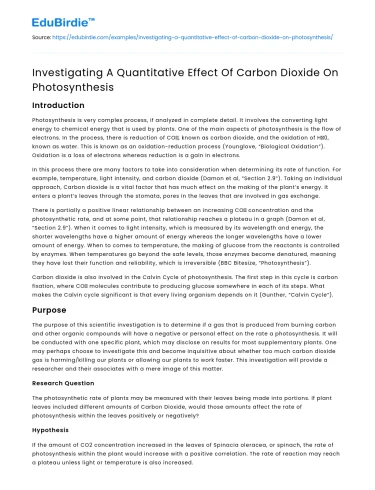Introduction
Photosynthesis is very complex process, if analyzed in complete detail. It involves the converting light energy to chemical energy that is used by plants. One of the main aspects of photosynthesis is the flow of electrons. In the process, there is reduction of CO₂, known as carbon dioxide, and the oxidation of H₂0, known as water. This is known as an oxidation-reduction process (Younglove, “Biological Oxidation”). Oxidation is a loss of electrons whereas reduction is a gain in electrons.
In this process there are many factors to take into consideration when determining its rate of function. For example, temperature, light intensity, and carbon dioxide (Damon et al, “Section 2.9”). Taking an individual approach, Carbon dioxide is a vital factor that has much effect on the making of the plant’s energy. It enters a plant’s leaves through the stomata, pores in the leaves that are involved in gas exchange.
Save your time!
We can take care of your essay
- Proper editing and formatting
- Free revision, title page, and bibliography
- Flexible prices and money-back guarantee
There is partially a positive linear relationship between an increasing CO₂ concentration and the photosynthetic rate, and at some point, that relationship reaches a plateau in a graph (Damon et al, “Section 2.9”). When it comes to light intensity, which is measured by its wavelength and energy, the shorter wavelengths have a higher amount of energy whereas the longer wavelengths have a lower amount of energy. When to comes to temperature, the making of glucose from the reactants is controlled by enzymes. When temperatures go beyond the safe levels, those enzymes become denatured, meaning they have lost their function and reliability, which is irreversible (BBC Bitesize, “Photosynthesis”).
Carbon dioxide is also involved in the Calvin Cycle of photosynthesis. The first step in this cycle is carbon fixation, where CO₂ molecules contribute to producing glucose somewhere in each of its steps. What makes the Calvin cycle significant is that every living organism depends on it (Gunther, “Calvin Cycle”).
Purpose
The purpose of this scientific investigation is to determine if a gas that is produced from burning carbon and other organic compounds will have a negative or personal effect on the rate a photosynthesis. It will be conducted with one specific plant, which may disclose on results for most supplementary plants. One may perhaps choose to investigate this and become inquisitive about whether too much carbon dioxide gas is harming/killing our plants or allowing our plants to work faster. This investigation will provide a researcher and their associates with a mere image of this matter.
Research Question
The photosynthetic rate of plants may be measured with their leaves being made into portions. If plant leaves included different amounts of Carbon Dioxide, would those amounts affect the rate of photosynthesis within the leaves positively or negatively?
Hypothesis
If the amount of CO2 concentration increased in the leaves of Spinacia oleracea, or spinach, the rate of photosynthesis within the plant would increase with a positive correlation. The rate of reaction may reach a plateau unless light or temperature is also increased.
This is the predicted outcome of the experiment. Subjects incorporating higher amounts of CO₂ (2g & 2.5g) are expected to result in a graph that has similarity to the higher bar. Subjects incorporating amounts of CO₂ (1g & 1.5g) will result in a graph showing resemblance to the middle bar, followed by subjects including lower amounts of CO₂ (0g & 0.5g) reflecting the shortest bar. The Y values represent the productivity as a percentage.
Data Evaluation
The results of this experiment reflect on the rate of photosynthesis in Spinacia oleracea when it comes to applying variable amounts of carbon dioxide into the process. Over the course of both trials the number of chads that floated in the 0-gram solution remained at zero, resulting in a mean productivity of zero-percent over the course of a 15-minute period. What also stands out from the results is the 1-gram solution reaching perfect productivity in both trials. It is appropriate to say that if there is no carbon dioxide present, the plant will have little to no rate in this biological process. However, instead of a surplus amount, a moderate amount would result in better one. Scientists and researchers have claimed that once a high enough amount of CO₂ is present, the rate reaches a plateau. This is seen as false in the results because the productivity decreased rather than remained steady, as the amounts increased.
In the data containing the probability percentages, there is a repeated pattern in both trials. If the values of those percentages were put onto a line graph, a zigzag line appears. What this may indicate is that whole number amounts of the baking soda (1g & 2g) are somewhat more promising and useful.
Conclusion
We can conclude that there is a positive correlation between more moderate amounts of carbon dioxide and the rate/productivity of photosynthesis in plants. What was being investigated was simply this issue. The condition of the data moved towards disproving the predicted outcome that the highest amount of baking soda would result in the highest photosynthetic rate. In the bar graph showing the mean productivity over both trials, the 1 gram, the medium amount, made perfection, while the 2.5 grams did significantly worse.
Sources
- “Photosynthesis.” BBC Bitesize, BBC, www.bbc.com/bitesize/guides/zx8vw6f/revision/2.
- “Section 2.9.” Higher Level Biology, by Alan Damon et al., 2nd ed., Pearson Education Limited, 2014, pp. 108–109.
- Gunther, Tim, and Mikayla Trotter. “Calvin Cycle.” National Geographic Society, National Geographic, 9 Nov. 2012, www.nationalgeographic.org/media/calvincycle/.
- Younglove, Brent. 'Biological Oxidation.' Libretexts.
- https://chem.libretexts.org/Bookshelves/Biological_Chemistry/Supplemental_Modules_(Biological_Chemistry)/Metabolism/Catabolism/Biological_Oxidation






 Stuck on your essay?
Stuck on your essay?

